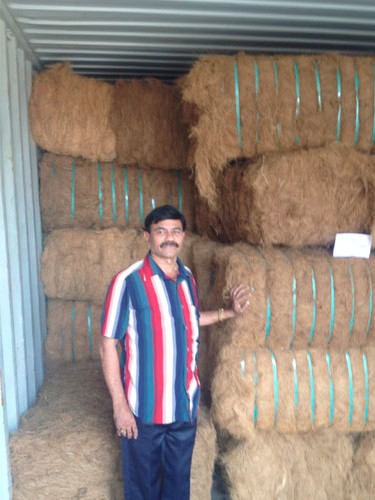News > Export News
The market is only coconut fiber globally
(
Update:
20/10/2017
)
Only coconut fiber prices have fallen in the fourth quarter of 2016 and continue to decline in the first half of 2017. In Sri Lanka, the average price of coarse coconut coir has dropped to 123 USD / tonne in June 2017 after at the beginning of the fall in 2/2016. Meanwhile, the price of coconut fiber in Indonesia began to decline in the fourth quarter of 2016 and dropped to 236 dollars per ton in June 2017. The economic downturn in China (the top importer of coarse coconut only) and the demand for higher value-added products are causing the demand for raw coir fiber to decline. Low and dragging down the price of this product is also down.
Although the coconut fiber price trend is declining, the coconut industry is generally on the upward trend in the global market; especially coconut fiber products with added value. At present, only coconut fiber and coir products such as coir mats, carpet mats, foot mats and net covers are estimated at over $ 1 billion. Of this total, more than 85% of total exports are from India, Sri Lanka and Indonesia - these are considered major producers, and the remaining exports to Thailand, the Philippines and Malaysia.
Strong domestic demand coupled with India's share of exports was only 1% of the world's total exports in 1996 and by 2002 it rose sharply to 11%, then doubled. to 25% by 2013. The latest statistics show that India's coconut coir and coconut coir exports only increase by more than 27% in 2016-2017.
In Sri Lanka, the export turnover of Sri Lanka is expected to increase 18.7% in 2016, mainly to increase the turnover of finished products such as coconut husk, coconut coir products, brushes and brushes made from coconut fiber . India and Sri Lanka are more focused on value-added products. Meanwhile, Indonesia is still struggling to develop coconut fiber industry and recently the country mainly focused on producing coarse coir. China is still the main importer of coconut fiber products, its market share in the global market is more than 50% of world imports despite its recent challenges. due to declining economy.
Exports of coconut fiber products from India continue to increase as the market is gradually improving. According to the latest statistics from the Indian Coir Fiber Commission, from April 2016 to March 2017, India exported 957,045 tonnes of coir and coir products to the global market. Turnover reached 228,165 million rupiah ($ 352.6 million), an increase of about 20% over the same period last year to $ 293.9 million. This figure may increase further as demand from import markets such as China and the United States is rising.
India exports about 14 types of coconut fiber products to the world market including semi-finished products such as coconut fiber, foot scrub, carpet mat, coconut fiber coats and other finished products such as coated mesh earth and carpet. Among coconut fiber products, India mainly exports coconut husks and coconut fiber. From April 2016 to March 2017, the exports of these two products accounted for 89% of total coconut fiber exports from India. In this period, the export of the two main products is increasing, so the total export of coconut fiber products from India increased. Acacia exports increased by 31.6% and coconut fiber by 29.1%. Other coir products also recorded the highest increase in both production (451.9%) and exports (339.5%). China, the United States, the Netherlands, South Korea, and Italy are the main import markets for coco bean from India with respective market share of 45.96% 13.95%, 13.95%, 8.62% 6.01% and 3.55%.
Meanwhile, Japan is still the main importer of Sri Lankan coir products. Japan imports coco peat and most of it is used for agriculture, fertilizing, animal feeding, and sometimes for animal bedding. In the period January - March 2017, Japan imported 14,736 tons of coconut, accounting for 27.7% of total exports (53,244 tons of coconut) in Sri Lanka. Coconut husks contributed to the highest export value of Sri Lankan coconut products, reaching 41.4%. Other import markets for Sri Lanka's coconut products include Mexico, South Korea, China, United States, United Kingdom, Spain and Iran. These markets have imported coconuts varying from 6,852 tonnes to 1,866 tonnes. Total acacia imports from these markets were 26,297 tonnes, 49.4% of Sri Lanka's total coconut exports. Compared with the previous year, the coconut export volume has been on the upward trend, rising by 1%. Furthermore, the land cover is one of Sri Lanka's coir products with the highest increase in exports over the same period last year. Net exports of netting products were up 56%, up from 780 tonnes in 2016 to 1,219 tonnes in 2017.
Unlike India and Sri Lanka, among coir products, Indonesia mainly exports non-coir products, coconut fiber. Exports of coconut fiber from Indonesia from January to March 2017 reached 5,013 tons, turnover reached 1.1 million USD. Total exports decreased by more than 37% against the same period last year. China is the major importer of coconut fiber from Indonesia. China collected 3,256 tonnes of coconut fiber, reaching 65%. Import markets include Korea, Japan, Malaysia and Singapore. Raw coconut fiber is the only coir product from Indonesia that is exported to the global market in the above period. The export situation of other coconut fiber products from Indonesia has decreased significantly both in output and turnover.
Printed by COCOMMUNITY, VOL. XLVII NO. July 1, 2017
